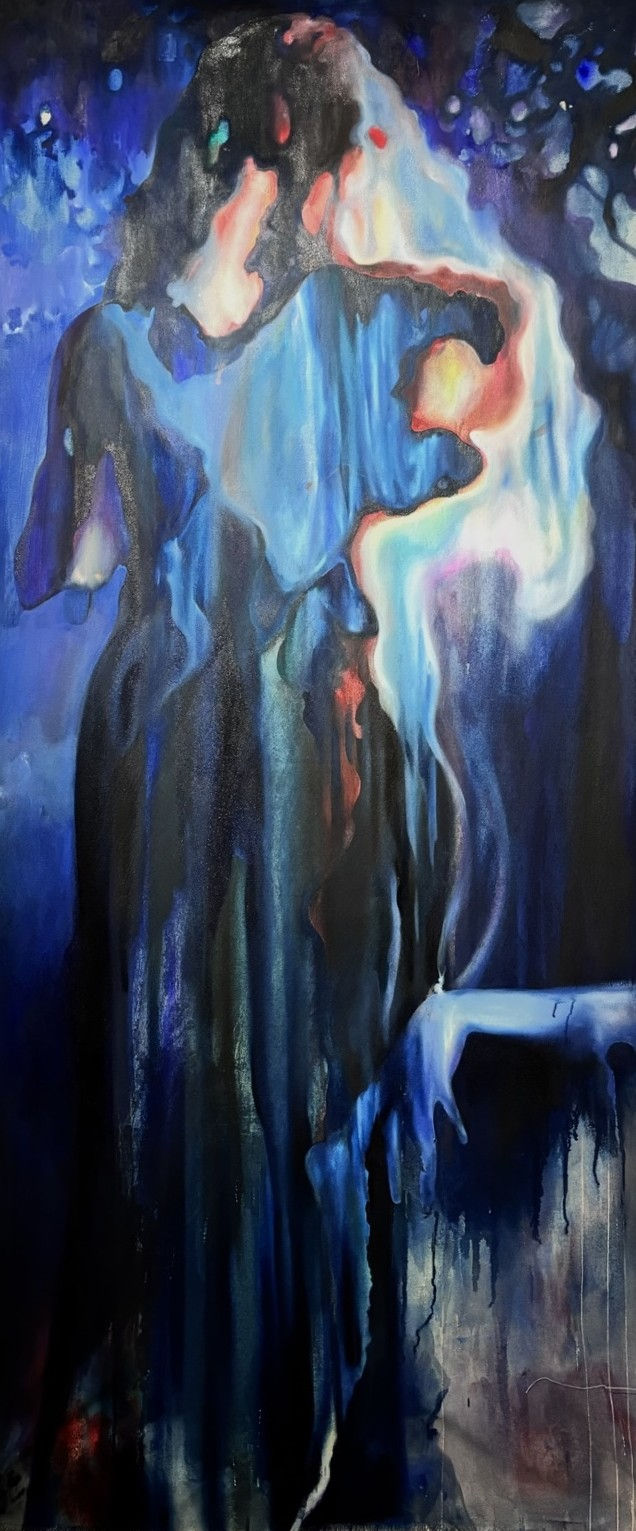Spring Pop-Up Series
May 22 – 29, 2025
Opening Reception: Friday, May 23, 6-8 pm
co-organized by Yena Park
Jakupsil is pleased to present TRACE, a group exhibition featuring works by eight artists from School of Visual Arts MFA program: Jieun Cheon, Ruoxi Hua, Korkimon, Yoorim Ko, Zengyuan Ma, Yena Park, Kutay Tufekci, and Yue Yuan. The exhibition explores the corporeal and incorporeal vestiges that define existence—marks inscribed upon bodies, spaces, memories, and psyches. Through painting, installation, and mixed media, these artists excavate the residual imprints of lived experience, navigating the territories between presence and absence, the tangible and ethereal. The title, TRACE, captures themes of memory, remnants, embodiment, and liminality that course through their practices. In an era shaped by displacement and digital mediation, they question what remains when connection fractures and identity disperses. The exhibition aims to map such thresholds—between belonging and estrangement, visibility and erasure, preservation and decay—that resist categorization.
"To live is to leave traces." — Walter Benjamin
The exhibition begins with works that explore stratification and systematic deconstruction. Cheon, Hua, and Tufekci each address the tension between structural order and its inevitable collapse through varied formal strategies. Cheon's Uncanished Workld—An Epistemological Inquiry builds a fictional universe where rationality falters against reality and understanding remains incomplete. Using drawing, sculpture, text, and craft-based processes, her installations function as epistemological chapters—The Calendar of the Permutations of 1000 Arms and The Anti-Fractal Map—where scientific diagrams meet religious iconography and mythological fragments. Her layered systems visualize paradoxes: order within chaos, knowledge against belief, creating archaeological traces of both rational and spiritual attempts to comprehend existence. Similarly, Hua's paintings delve into non-places—transitional, anonymous spaces designed for efficiency over meaning. He examines interstitial spaces designed for maximal function and minimal aesthetics: side streets, subway stations, parking lots, public bathrooms. In The Green Stripes and Pack Your Bags… for Nowhere at All, Hua employs sharp linear elements that divide and connect, while extreme cropping withholds contextual clues, reflecting the disorientation of routine navigation in depersonalized environments. His compositions foreground the psychological estrangement inherent in spaces built for transit rather than habitation—capturing traces of human passage through deliberately impersonal territories.
While Cheon maps traces within beliefs and systems, and Hua hints at spatial alienation, Tufekci investigates digital imaging process via analog means. His paintings are built in layers, each treated as a distinct unit of visual information. Using chip brushes, airbrushes, permanent markers, masking tape, and an orbital sander, he constructs and distresses surfaces that retain traces, pentimento, of their making. Paint accumulates into textured palimpsests, marked by acts of removal and abrasion. Stencil silhouettes create trompe l'oeil effects that guide the eye across fractured compositions. In C4M3L CRU5H, what he calls surface trauma becomes a structural device—illusion and erosion intertwine to build a visual archaeology. These material traces on Tufekci's surfaces echo how external forces mark more intimate territories.
"The body is the inscribed surface of events." — Michel Foucault
The body emerges as contested terrain throughout the exhibition, with Korkimon's practice foregrounding corporeal transformation through formal distortion. Her large-scale graphite drawings deploy monstrous figuration to examine the impossibility of complete interpersonal access. The precision with which she renders anatomically ambiguous forms produces tension between representation and dissolution. Through works like Grab A Granny, she enacts the paradoxical gesture of attempting to reassemble what was never whole. Yuan's approach involves layering acrylic and colored pencil to create palimpsestic surfaces where bodies emerge and recede. In Appendix, she presents double entangled figures reminiscent of Francis Bacon—bodies caught in metamorphosis, where flesh slides across skeleton in chromatic waves. Her work questions whether we are truly who we appear to be, positioning the body as a site of perpetual becoming rather than a fixed entity. Ma's The Tree in the Garden and the Tree in the Wild employs botanical-anatomical hybridization. Having long seen women as trees—independent yet validated by external perception—Ma juxtaposes those "pruned into uniform beauty" against those "growing wild in the mist." Her Witch Hunt presents an alternative feminist reading where feminine divinity faces immolation rather than sanctification—a critique of aesthetic standardization through formal means.
Park and Ko engage with absence through distinct technical approaches. Park employs untreated fabric as compositional foundation, foregrounding the substrate while signifying intentional incompletion. Her chromatic methodology utilizes blues and greens to articulate spatial recession, while surreal elements create perceptual instability. Curtains in her compositions symbolize inaccessible realms, while clothing lines represent layers of memories, leaving only faint traces. Eyes become crucial motifs conveying contrasting emotions, and disappearing pearl necklaces symbolize impermanence—visual metaphors rendered through technical precision. Ko builds translucent washes and textured passages of acrylic and oil pastel that interrupt and animate the surface. Her investigation of "aura" positions color not as ornamental but ontological—a medium through which unseen energies are felt and rendered. Her approach produces visual fields simultaneously ephemeral and structured, engaging themes of transformation and emotional presence. The paintings offer contemplative spaces for subtle encounters with presence, where materiality becomes a conduit for sensation rather than depiction.
From bodily imprints to spatial remnants, varied traces manifest throughout the exhibition. Works on view collectively engage with palimpsestic accumulation—the way meaning is constructed through layers of material, memory, and cultural inscription. TRACE invites contemplation of what persists when physical proximity fails, when societies enforce conformity, and when understanding confronts its limitations. The works occupy threshold spaces—between abandonment and attachment, order and chaos, dissolution and connection—testifying to art's capacity to preserve and transform the residual marks of being. The exhibition offers not discrete objects but a constellation of temporal and spatial incursions—moments where absence becomes presence, where memory materializes between what is revealed and what is withheld.
Hours: 10AM - 6PM Daily
30-43 31st Street, Astoria NY
VIEW MAP
Inquiries:
T. +1 215 906 5200
E. brett.jakupsil@gmail.com
W. www.jakupsil.com
IG. @jakupsilny
WORKS ON VIEW
































Inquiries: brett.jakupsil@gmail.com | +1 215 906 5200














